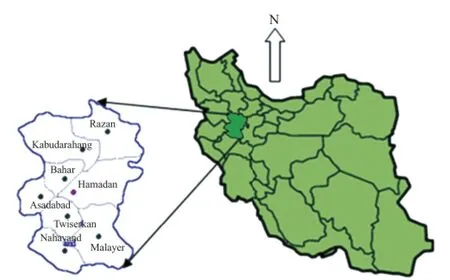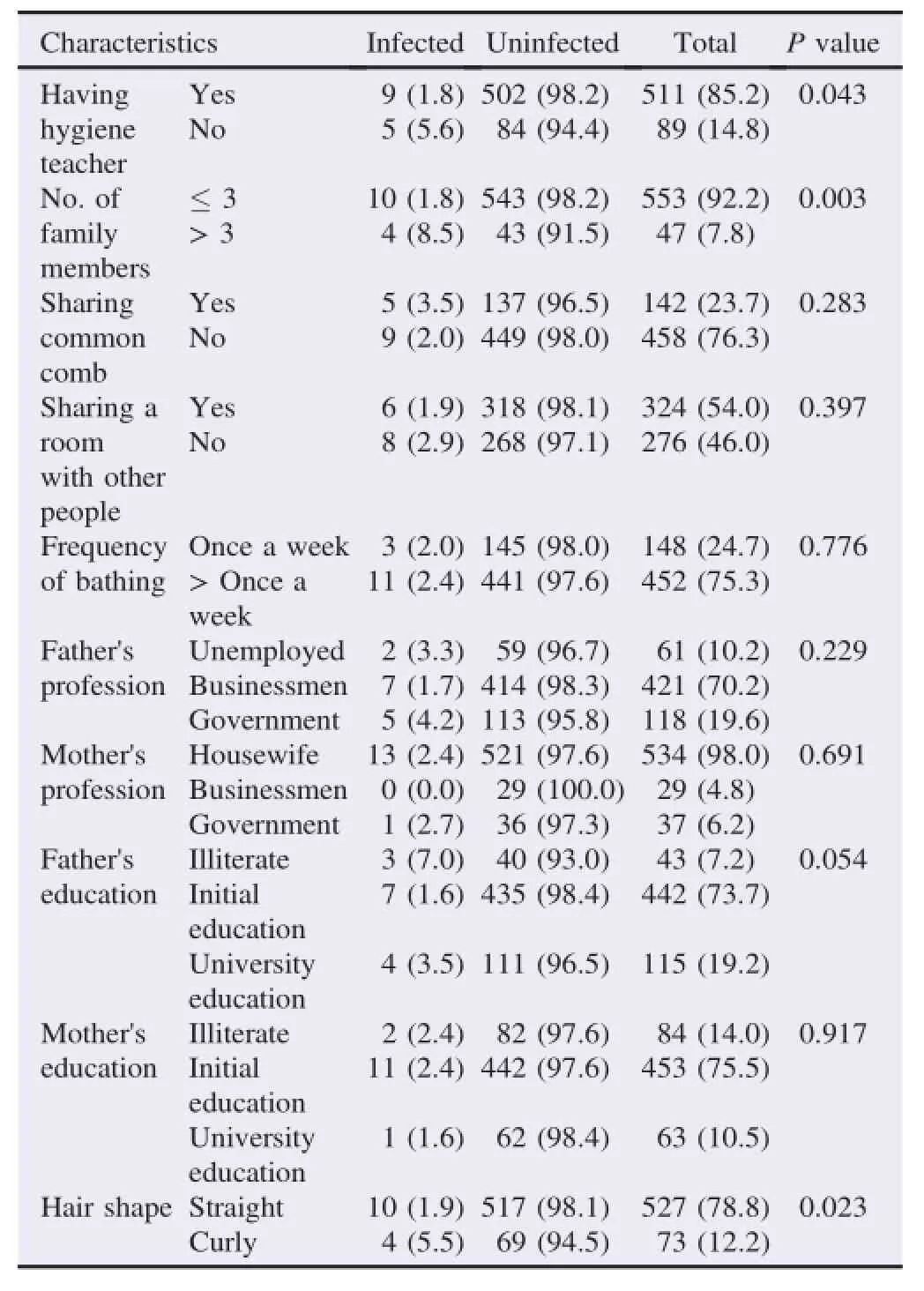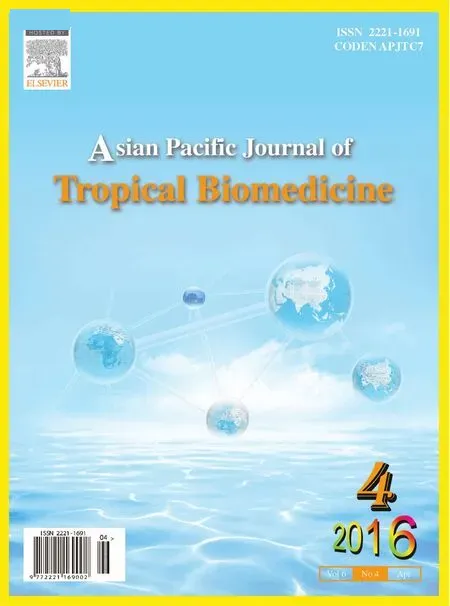Pediculosis capitis among p rimary and m idd le school children in Asadabad,Iran:An epidem iological study
Mansour Nazari,Reza Goudarztalejerdi,Mostafa Anvari PaymanDepartment of Medical Entomology,School of Medicine,Hamadan University ofMedical Sciences,Hamadan,Iran
Original article http://dx.doi.org/10.1016/j.apjtb.2016.03.002
ARTICLE INFO
Article history:
Received in revised form 15Oct,2nd revised form 26Oct,3rd revised form 10Dec,4th revised form 25Dec2015 Accepted 15 Jan 2016
Availableonline10Mar2016
Pediculosis capitis among p rimary and m idd le school children in Asadabad,Iran:An epidem iological study
Mansour Nazari*,Reza Goudarztalejerdi,Mostafa Anvari Payman
Department of Medical Entomology,School of Medicine,Hamadan University ofMedical Sciences,Hamadan,Iran
Original article http://dx.doi.org/10.1016/j.apjtb.2016.03.002
ARTICLE INFO
Article history:
Received in revised form 15Oct,2nd revised form 26Oct,3rd revised form 10Dec,4th revised form 25Dec2015 Accepted 15 Jan 2016
Availableonline10Mar2016
Head lice
Pediculosis
School students Prevalence
Epidem iology
ABSTRACT
Ob jective:To investigate the prevalence of head lice in primary and m iddle school children in Asadabad,Iran.
M ethods:This study is an analytical descriptive cross-sectional one conducted among primary andm iddle school children in Asadabad during the academ ic yearof 2013–2014. Data were collected at baseline via questionnaire,checklist and head examination.
Results:A totalof600 studentswereexamined(412 girlsand 188 boys),and 14 students showed pediculosis.And the total prevalence ratewas 2.3%(3.2%girls and 0.5%boys). The infestationwasequalin public and private schools.The rateof pediculosiswashigher in studentsof primary schools(4.0%)than those inm iddle schools(0.7%).Theageof the students ranged from 6 to 14 years.The totalnumberof infected group was 14 w ithmean ageof 8.93±2.43 years,and itwas 586 w ithmean age of 10.98±2.82 years for the uninfected group who were enrolled in the study(P<0.01).This study showed signi fi cant differences between students with curly hair(5.5%)and those w ith straight hair(1.9%) when compared in termsofhead lice infestation(P<0.05).The relationsofpediculosisand other socioeconom ic factorssuch assharing common comb and a room w ith otherpeople, frequency ofbathing,and parents'professionand educationwereanalyzed,and Chi-square testdid notshow astatistically signi fi cantrelationship betweenhead licecontam ination and the abovementioned socioeconomic factors(P>0.05).
Conclusions:It isnecessary to fi nd the risk factorsof the infection in order to understand how to control or decrease infection in students,considering the important role of health education in reduction of head lice infections.
1.Introduction
The head louse,pediculus humanus capitis(De Geer,1778) (Anoplura:Pediculidae),is a worldw ide community health concern[1].Pediculosis represents an emerging social problem in all parts of the world and in every race,socioeconom ic status,fam ily background,or personal habit[2,3].Head lice is usually diagnosed by three different manifestations including itching and in fl ammation of the scalp and neck,sighting of lice,and detection of eggs attached to hair shafts[4,5].The head louse is a kind of blood-sucking insect which can cause pruritus(that is the most common symptom),excoriation, conjunctivitis,and secondary bacterial infestations[6].Lice infestation dates back to 25 m illion years ago in primates[7]. Fertilized eggs of sucking lice are called nits and are fi rm ly cemented to the hair shaft.Subsequently,eggs develop through three nymph instars before reaching adulthood[8]. Pediculosis is more common in young girls and those in crowded fam ilies,especially because of using sim ilar hair products[9].Schools,particularly primary ones,are places which play the main role in starting the prevalence of contagious disease and infestations such as the pediculosis epidem ic[10].A lmost all human head lice and scabies infestations occur by direct host-to-host contact[11–13].
Many studies have been performed in Iran,comparing the social status and the rate of pediculosis in different cities.In the city of Asadabad,no studies have been recently done onpediculosisinfestation levels.Therefore,theaim of thiswork is to investigate the prevalence of head lice in primary and m iddle school children in Asadabad,Iran.In addition,the in fl uence of different risk factors on pediculosis infestation such as gender, haircharacteristics,and socioeconom ic factorshavebeen studied.
2.M aterials and methods
2.1.Study area
Asadabad is a city in Hamadan Province,Iran.It lies at 34°37′–34°50′N,47°51′–47°90′E,and altitude of 1 591m.It has a population of 59617,making it the 5th biggest city in Hamadan(Figure 1).

Figure 1.Location of Asadabad City in Hamadan Province,Iran.
2.2.Samples and data collection
The present research is an analytical descriptive crosssectional study,conducted among primary and m iddle school children in Asadabad,Iran during the academ ic year of 2013–2014.Questionnaire,checklist,and head exam ination were the means to gather data at baseline.
The sample size was determ ined by considering an expected prevalence(P)of 50%w ith a 95%con fi dence and using the formula n=z2×P(1−P)/d2in which z=1.96 and d=0.04, which resulted in 600(188 boys and 412 girls)children.
In the second stage,the schools were selected according to their geographical distribution to cover the whole district,and they represented public and private schools(16 primary and m iddle schools were random ly selected in Asadabad,and the studentswere systematically selected in these schools).
In order to evaluate the in fl uenceof socioeconom ic factorson pediculosis prevalence,an epidem iological survey was designed to record information about gender,type of school,hygiene teacher,job and education of parents,quali fi ed private bedroom, sharing a bed and blanket,frequency of bathing,sharing common comb,hair characteristics,and number of fam ilymembers. The criteria for diagnosis of pediculosiswere the presence of at leastone living adult,nymph,or viable nit[14].
2.3.Statistical analysis
The Chi-square test for homogeneity of proportions was employed to compare the prevalence between some variables. Con fi dence intervals of 95%for prevalence were determ ined. The results were presented as mean±SD for quantitative variables.The statistical analysiswas conducted w ith statistical software SPSS version 20.
3.Resu lts
A total of 600 students were examined(412 girls and 188 boys)among which only 14 students showed pediculosis,and the total prevalence rate was 2.3%.Pediculosis was more frequent in girls(13 out of 412,3.2%)than boys(1 out of 188, 0.5%)(P<0.05).
The infestation was equal in public schools(2.3%,n=514) and private schools(2.3%,n=84)(P>0.05).The rate of pediculosiswas higher in primary schools(4.0%,n=303)than m iddle schools(0.7%,n=297)(P<0.01).
The age of the students ranged from 6 to 14 years.The total numberof the infected groupwas14w ithmeanageof8.93±2.43 years,and itwas 586 w ith mean age 10.98±2.82 years in the uninfected group who were enrolled in the study(P<0.01).
The prevalence of head lice infestation was in fl uenced by socioeconom ic factors,as 8.5%of the infected cases had more than three fam ily members.In this study,the pediculosis infestation in school children who had hygiene teacher(1.8%) was less than those who did not(5.6%,P<0.05).This study con fi rmed signi fi cant differences between hair shapes when compared w ith head lice infestation(P<0.05).The prevalence of pediculosis in school childrenwho had straightand curly hair was 1.9%and 5.5%,respectively(Table 1).

Table 1 Head louse infestation in schoolpupilsaccording to some socioeconomic factors in Asadabad,Iran,2013–2014.n(%).
The relations of pediculosis and other socioeconom ic factors such as sharing common comb and a room w ith other people, frequency of bathing,and parents'occupation and education were investigated.Chi-square test did not show a statistically considerable relationship between the head lice contam ination and socioeconom ic factors mentioned above(P>0.05) (Table 1).
4.Discussion
Head lice infestation is one of the major public health problemsw ith aworld-w ide distribution[15].The lack of data on the epidem iology of head lice could hamper and disrupt the strategy for pediculosis control in Asadabad.
The highest percentage of this incidence is seen in children aged fi ve to twelve years;however,this incidence is increasing in the range of 24–36 years old group due to their exposure to infected children[9].
The prevalence of head lice in children found in this study was 2.3%(3.2%girls and 0.5%boys).The results of this study are consistent w ith other studies carried out in Iran where the rate of contam ination was reported to be 4.8%in Khaje City, including 6.66%girls and 2%boys[15].However,in Aran and Bidgol,the amount of head lice contam ination in female and male students of primary schools was 0.42%and 0.05%, respectively[16].In Hamadan,Iran,the general prevalence was 6.85%(girls:13.5%;boys:0.7%),and the number of girls who had been contam inated wasmore than boys[17].
The studies carried out abroad also support the fi ndings of this study.According to them,the rate reached 9.1%in Turkey, including 16.4%girls and 2.1%boys[18].The prevalence of head lice in Delhi was 16.59%,including 20.42%girls and 13.86%boys[19],and 13.3%in Yemen,including 18.9%girls and 8.6%boys[20].As it can be seen,in all of the abovementioned studies,the rate of infestation was higher in girls than boys.
Childrenaged 10–11 yearsweremost frequently infestedw ith pediculosis,which could be explained because of their age and head-to-head contact[21,22].Head lice infestationwasobserved to beacommon conditionamong primary schoolchildren,ashaving been documented by others[3,23].The number of infestationwas equal in public and private schools in Asadabad(2.3%),and this fi nding indicated a disagreementw ith other study results[6,24]. This study also proved that the school children w ith curly hair presented more prevalence rate than those w ith straight hair in contrast to what was believed at fi rst,disagreeing w ith the results obtained from the factor of hair shape by Borges and Mendes[25]and agreeing w ith those of another study[17].Many authors conceive that head lice prevalence can be associated w ith socioeconom ic factors[18,23,26].Head lice infestations are morew idespread in poor socioeconom ic status;and fam ily size, age,level of education,and personal hygiene are important factors in fl uencing its epidem iology[27].Results show that screening and treating head lice among children need to be done continuously in order to decrease the infestation rates [28,29].In our study,no differences were found between head lice contam ination and socioeconom ic factors like sharing common comb and a room w ith other people,frequency of bathing,and parents'jobs and education.
Socioeconom ic status is a major factor in fl uencing the occurrence of pediculosis among school children of both sexes. Improving standards of living and personal hygiene can signi fi cantly reduce pediculosis capitis in school children in Asadabad.Consequently,it is necessary to fi nd the risk factors of the infection so as to understand how to control or decrease infections in students,taking into account the important role of health education in reduction of head lice infection.
Con fl ict of interest statement
We declare thatwe have no con fl ict of interest.
Acknow ledgm ents
This investigation received fi nancial support from Hamadan University of Medical Sciences(Grant No.9212134352).The authors are grateful to all the authorities of the primary and m iddle school children in Asadabad City,Iran,where human head licematerialswere collected.
References
[1]Lee SH,Clark JM,Ahn YJ,LeeWJ,Yoon SK,Kwno DH,etal. M olecularmechanisms and monitoring of permethrin resistance in human head lice.Pestic Biochem Physiol 2010;97:109-14.
[2]Ketzis JK,Clements K,Honraet K.Use of a poultry model to assess the transfer inhibition effect of head lice(Pediculus humanus capitis)products.Parasitol Res 2014;113(5):1943-8.
[3]Frankowski BL,Bocchini JA Jr;Council on School Health and Committee on Infectious Diseases.Head lice.Pediatrics 2010; 126(2):392-403.
[4]Nutanson I,Steen CJ,Schwartz RA,Janniger CK.Pediculus humanus capitis:an update.Acta Dermatovenerol Alp Panon Adriat 2008;17:147-54,156-7,159.
[5]Akhter S,MondalMMH,Alim MA,Moinuddin MA.Prevalence of lice infestation in humans in different socioeconomics status at M ymensingh in Bangladesh.Int J Biol Res 2010;1:13-7.
[6]Lesshafft H,Baier A,Guerra H,Terashima A,Feldmeier H. Prevalence and risk factorsassociated w ith pediculosis capitis in an impoverished urban community in Lima,Peru.JGlob Infect Dis 2013;5(4):138-43.
[7]Reed DL,Light JE,Allen JM,Kirchman JJ.Pair of lice lost or parasites regained:the evolutionary history of anthropoid primate lice.BMC Biol 2007;5:7.
[8]FerrisGF.The sucking lice.Pac Coast Entomol Soc Mem 1951;1: 1-320.
[9]C lore ER,Longyear LA.Comprehensive pediculosis screening programs for elementary schools.JSch Health 1990;60:212-4.
[10]Rassami W,Soonwera M.Epidemiology of pediculosis capitis among school children in the eastern area of Bangkok,Thailand. Asian Pac J Trop Biomed 2012;2(11):901-4.
[11]Feldmeier H.Diagnosis of head lice infestations:an evidencebased review.Open Dermatol J 2010;4:69-71.
[12]NazariM,AziziA.Epidemiologicalpattern ofscabiesand its social determinant factors inwestof Iran.Health 2014;6(15):1972-7.
[13]NazariM,Moradi A,Anvari Peyman M.Epidemiological survey of scabies in the central prison of Hamadan in 2013.Pajouhan Sci J 2015;13(3):1-7.
[14]Pollack RJ,Kiszewski AE,Spielman A.Overdiagnosis and consequent m ismanagement of head louse infestations in North America.Pediatr Infect Dis J 2000;19:689-93.
[15]Shayeghi M,Paksa A,Salim Abadi Y,Sanei Dehkoordi A, AhmadiA,EshaghiM,etal.Epidemiology of head lice infestation in primary schoolpupils,in Khajeh City,EastAzerbaijan Province. Iran J Arthropod Borne Dis 2010;4(1):42-6.
[16]Doroodgar A,Sadr F,Sayyah M,Doroodgar M,Tashakkor Z, Doroodgar M.Prevalence and associated factors of head lice infestation among primary schoolchildren in city of Aran and Bidgol(Esfahan Province,Iran),2008.Payesh(Health Monitor) 2011;10(4):439-47.
[17]NazariM,FakoorzibaMR,ShobeiriF.Pediculus capitis infestation according to sex and social factors in Hamedan,Iran.Southeast Asian J Trop Med Public Health 2006;37(Suppl 3):95-8.
[18]O˘guzkaya AM,Baykan Z,KoçAN.The prevalence of pediculus capitis in students of eight primary schools in the rural area of the Kayseri province.Turkiye Parazitol Derg 2006;30:112-4.
[19]Khokhar A.A study of pediculosis capitis among primary school children in Delhi.Indian JMed Sci 2002;56:449-52.
[20]Al-M aktariMT.Head louse infestations in Yemen:prevalence and risk factors determination among primary schoolchildren,Al-Mahweet Governorate,Yemen.J Egypt Soc Parasitol 2008; 38(3):741-8.
[21]Vahabi A,Shemshad K,Sayyadi M,Biglarian A,Vahabi B, Sayyad S,etal.Prevalence and risk factorsof Pediculus(humanus) capitis(Anoplura:Pediculidae),in primary schools in Sanandaj City,Kurdistan Province,Iran.Trop Biomed 2012;29(2):207-11.
[22]Kalu EI,W agbatsoma V,Ogbaini-Emovon E,Nwadike VU, Ojide CK.Age and sex prevalence of infectious dermatoses among primary school children in a rural South-Eastern Nigerian community.Pan Afr Med J 2015;20:182.
[23]AL-Shawa RM.Pediculus capitis,infestation according to sex and social factors in Gaza Governorate.Islamic Univ J Ser Nat Stud Eng 2008;16(1):75-83.
[24]Dehghanzadeh R,Asghari-Jafarabadi M,Salimian S,Asl Hashemi A,Khayatzadeh S.Impact of family ownerships,individual hygiene,and residential environments on the prevalence of pediculosis capitis among schoolchildren in urban and rural areas of northwestof Iran.Parasitol Res 2015;114(11):4295-303.
[25]Borges R,M endes J.Epidemiological aspects of head lice in children attending day care centres,urban and rural schools in Uberlandia,central Brazil.Mem Inst Oswaldo Cruz 2002;97(2): 189-92.
[26]Nazari M,Goudarztalejerdi R,Moradi A.Investigation of pediculosis prevalence and associated factors in the central prison of Hamadan in 2013.Pajouhan Sci J 2015;13(2):13-20.
[27]Gazmuri BP,Arriaza TB,Castro SF,Gonzalez NP,Maripan VK, Saavedra RI.[Epidem iological study of pediculosis in elementary schools of Arica,Northern Chile].Rev Chil Pediatr 2014;85(3): 312-8.Spanish.
[28]Burgess IF,Burgess NA.Dimeticone 4%liquid gel found to killall lice and eggsw ith a single 15m inute application.BMC Res Notes 2011;4:15.
[29]Muhammad Zayyid M,Saidatul Saadah R,Adil AR,Rohela M, Jamaiah I.Prevalence of scabiesand head lice among children in a welfare home in Pulau Pinang,Malaysia.Trop Biomed 2010; 27(3):442-6.
29 Sep 2015
*Corresponding author:Mansour Nazari,Department of Medical Entomology, School of Medicine,Hamadan University of Medical Sciences,Hamadan,Iran.
Tel:+98 918 316 6540
E-mail:ynazari@yahoo.com
The study p rotocol was performed according to the Helsinki declaration and approved by the Ethics Comm ittee o f Research Deputy o f Hamadan University o f M edical Sciences,Hamadan,Iran.Inform ed w ritten consentw as obtained from participants.
Foundation Project:Supported by Hamadan University o f Medical Sciences (Grant No.9212134352).
Peer review under responsibility of Hainan M edical University.The journal implements double-blind peer review practiced by specially invited international editorial boardmembers.
2221-1691/Copyright©2016 Hainan Medical University.Production and hosting by Elsevier B.V.This is an open accessarticle under the CC BY-NC-ND license(http:// creativecommons.org/licenses/by-nc-nd/4.0/).
 Asian Pacific Journal of Tropical Biomedicine2016年4期
Asian Pacific Journal of Tropical Biomedicine2016年4期
- Asian Pacific Journal of Tropical Biomedicine的其它文章
- Susceptibility of Aedes albopictus from dengue outbreak areas to temephos and Bacillus thuringiensis subsp.israelensis
- Know ledge,attitude and recommenda tions for p ractice regarding dengue among the resident population of Queensland,Australia
- Sudden death in a captive mee rkat(Suricata surica tta)w ith arterial m edial and m yocardial calcification
- The African Moringa is to change the lives ofm illions in Ethiopia and far beyond
- Com putational in telligence in tropicalm edicine
- Risk factors from HBV infection among blood donors:A system atic review
